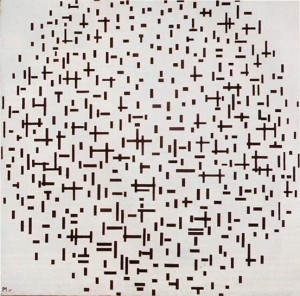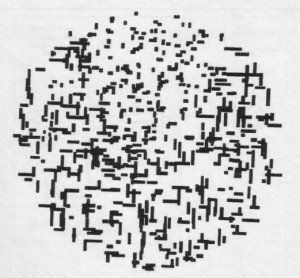Recently I began to get interested in using computer programming tools to attempt to replicate paintings from the early Modernist period, particularly those in the style of geometric abstraction. There were a number of reasons for this. Firstly, I have long been a fan of these works, from artists such as Kazimir Malevich, Piet Mondrian and El Lissitzky. Though their works, to the modern eye, may seem a little tame and academic, their departure from any type of representation was at the time truly revolutionary, living as they did through great political and scientific changes in the early part of the 20th century. I was also interested in introducing elements of interactivity into my own artworks, and thought this might allow me to develop some skills to this end. There was also an interest in the general area of trying to somehow codify aesthetics, to see if there was some sort of algorithm for beauty, a question which fascinates me. Also, I was enjoying dicking about with programs to see if I could make them do cool stuff.

The first painting I focused my attention on was a famous Mondrian work, Composition With Lines, from 1917. I was advised to try an open-source Java-based animation tool called Processing, and began to work with it. Due to the relative formal simplicity of the painting, I was able to get a passable program working which allowed the user to generate their own version of the artwork by moving the mouse around while holding down a button. (The working interactive sketch is here https://dominicfee.info/uncategorized/albers-simulator/) With a little research into other attempts to generate historical paintings with coding, I was surprised to find that I had been beaten to it by the American computer engineer A. Michael Noll, by about 50 years. In 1964 he had taken this exact painting and written a computer program to replicate it. Not only that, but according to research he did at the time, the majority of people he surveyed preferred his computer-generated artwork to the Mondrian original. The following pdf explains Noll’s methodology for the project, and draws some subjective comparisons between the genuine and simulated Mondrian paintings.
http://noll.uscannenberg.org/Art%20Papers/Mondrian.pdf
He makes some interesting observations on the fact that the simulated versions contained more randomness in the arrangements of the graphical elements than the genuine artwork as a result of the nature of the programming algorithms used. Despite this, the simulations created a more profound emotional response in the test subjects, causing Noll to speculate on the nature and perceived importance of the artist’s ability to manipulate and affect the emotional state of his audience.

